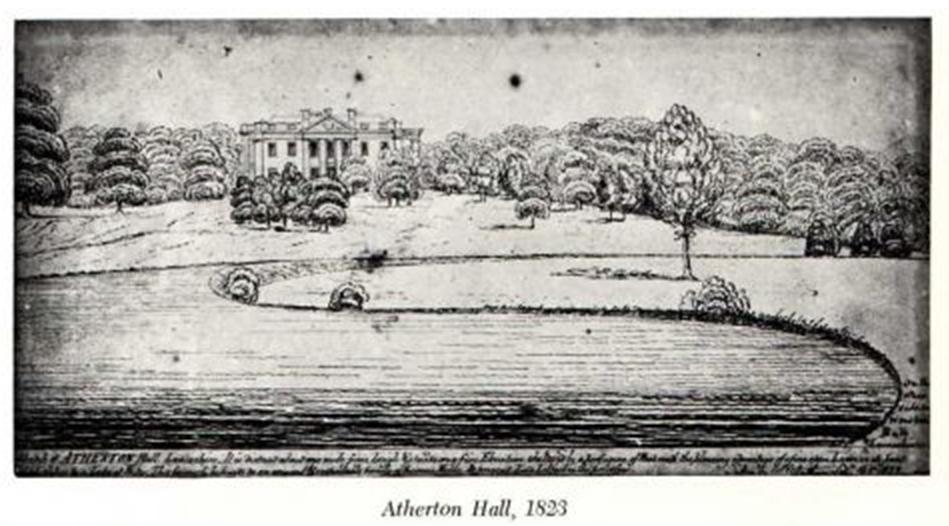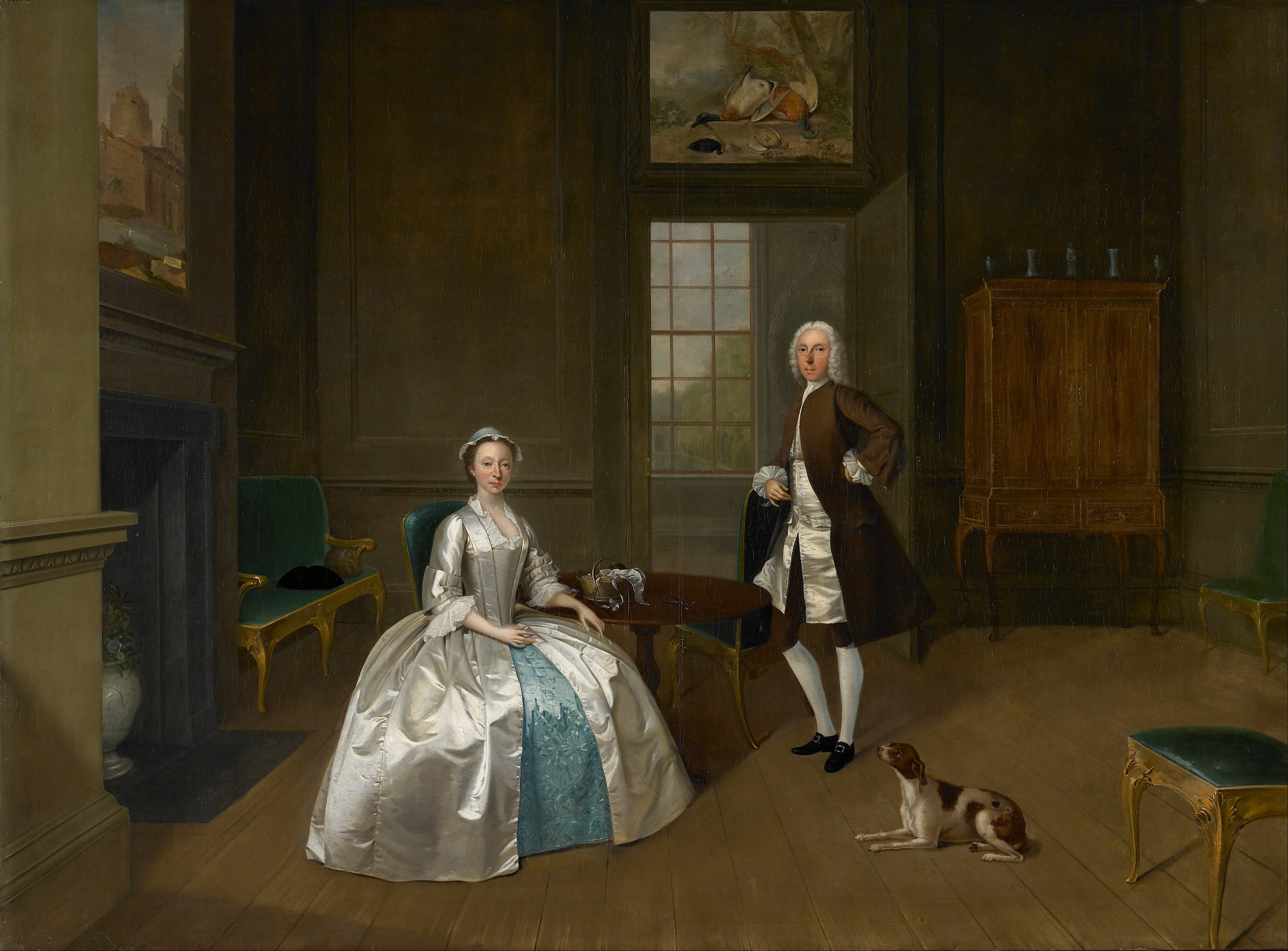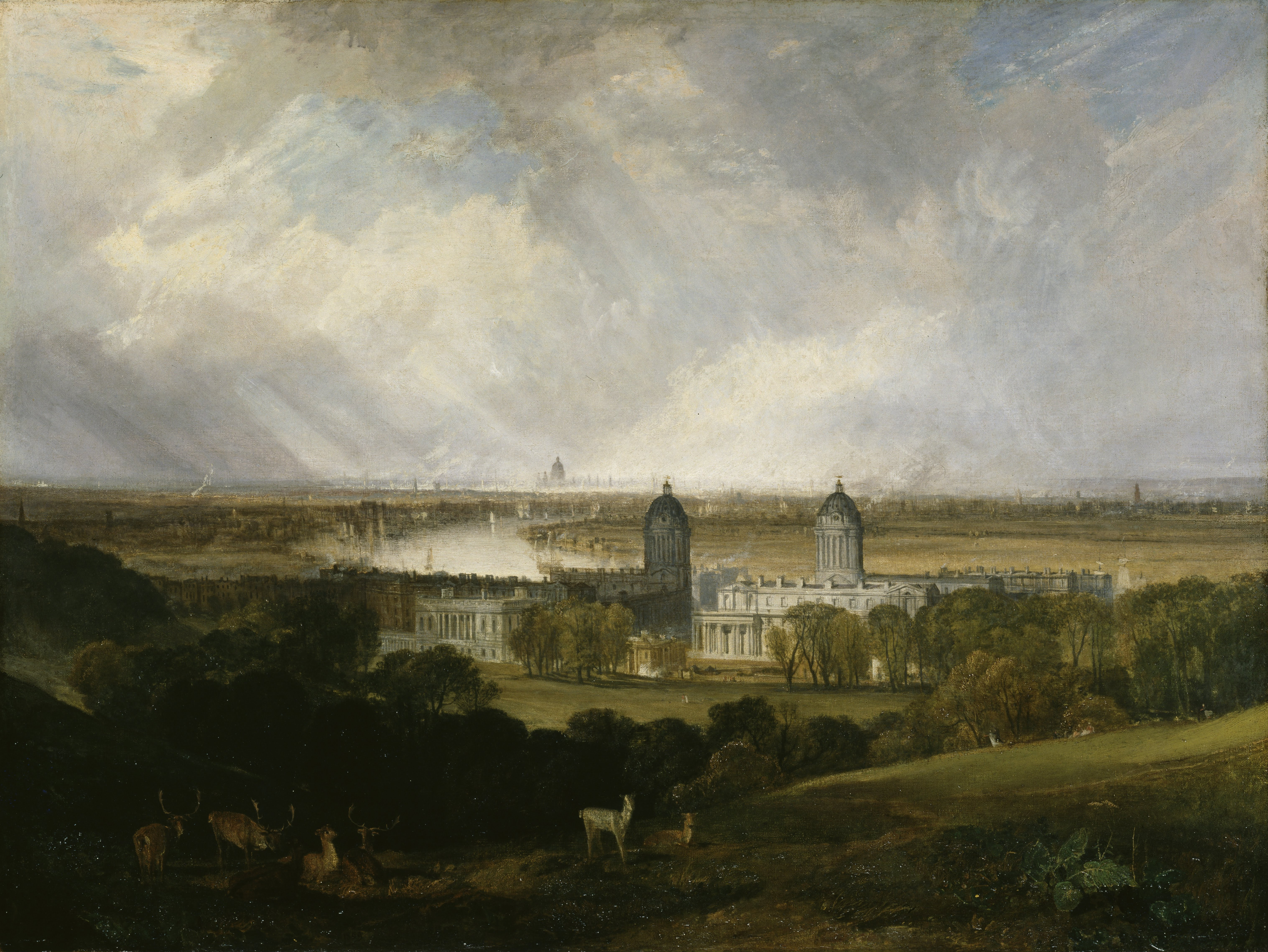|
Arthur Devis (1712-1787)
Arthur Devis (19 February 1712 – 25 July 1787) was an English artist, half-brother of the painter Anthony Devis (1729–1816), and father of painters Thomas Anthony Devis (1757–1810) and Arthur William Devis (1762–1822). His place in the pages of art history is generally as a painter of the type of portrait now called a conversation piece. Arthur was taught by the Flemish painter Peter Tillemans. Though his early work was in part as a landscape artist, he also drew upon family connections to win clientele for portraits of the members of pro-Jacobite Lancashire families. In fact, by 1737 he had gravitated to portrait painting, setting up a studio in London. In London Devis acquired a considerable reputation, though his success was to follow a certain parabola. Faced with other fashionable artistic currents represented by the work of such painters as Joshua Reynolds and Johann Zoffany, his commissions declined and he was obliged to move to restoring pictures. His marri ... [...More Info...] [...Related Items...] OR: [Wikipedia] [Google] [Baidu] |
Arthur Devis Self-portrait
Arthur is a common male given name of Brythonic origin. Its popularity derives from it being the name of the legendary hero King Arthur. The etymology is disputed. It may derive from the Celtic ''Artos'' meaning “Bear”. Another theory, more widely believed, is that the name is derived from the Roman clan '' Artorius'' who lived in Roman Britain for centuries. A common spelling variant used in many Slavic, Romance, and Germanic languages is Artur. In Spanish and Italian it is Arturo. Etymology The earliest datable attestation of the name Arthur is in the early 9th century Welsh-Latin text ''Historia Brittonum'', where it refers to a circa 5th to 6th-century Briton general who fought against the invading Saxons, and who later gave rise to the famous King Arthur of medieval legend and literature. A possible earlier mention of the same man is to be found in the epic Welsh poem ''Y Gododdin'' by Aneirin, which some scholars assign to the late 6th century, though this is still a ma ... [...More Info...] [...Related Items...] OR: [Wikipedia] [Google] [Baidu] |
Sir Roger Newdigate
Sir Roger Newdigate, 5th Baronet (30 May 1719 – 23 November 1806) was an English politician who sat in the House of Commons between 1742 and 1780. He was a collector of antiquities. Early life Newdigate was born in Arbury, Warwickshire, the son of Sir Richard Newdigate, 3rd Baronet (who died in 1727) and inherited the title 5th Baronet and the estates of Arbury and of Harefield in Middlesex on the early death of his brother in 1734. He was educated at Westminster School and University College, Oxford, where he matriculated in 1736, and graduated M.A. in 1738; he contributed greatly to the university throughout the remainder of his life. He is best remembered as the founder of the Newdigate Prize on his death and as a collector of antiques, a number of which he donated to the university. The prize for poetry helped make the names of many illustrious writers. Political career From 1742 until 1747, he served as Member of Parliament (MP) for Middlesex, and in 1751, he began ... [...More Info...] [...Related Items...] OR: [Wikipedia] [Google] [Baidu] |
Okeover Hall
Okeover Hall is a privately owned Grade II* listed country house in Okeover, Staffordshire, England. It is the family seat of the Okeover family, who have been in residence since the reign of William Rufus. The house lies close to the border between Staffordshire and Derbyshire, which lies on the far side of the small River Dove. The Hall is not open to the public. The house and manor church (14th century, restored by Sir George Gilbert Scott) were pillaged by the Jacobite forces as they marched south to Swarkstone Bridge in 1745. In 1745–47, Leak Okeover had the old hall enlarged to Palladian designs by a London carpenter and joiner, Joseph Sanderson, a cousin of John Sanderson, the architect. The house is a testament to the high level of education and competence that might be elicited from a well-trained Georgian craftsman. The Georgian east wing is the oldest part of the house dating from 1745 to 1746. A north wing was demolished in the early 19th century. The south and we ... [...More Info...] [...Related Items...] OR: [Wikipedia] [Google] [Baidu] |
Atherton Hall, Leigh
Atherton Hall was a English country houses, country house and estate in Atherton, Greater Manchester, Atherton Historic counties of England, historically a part of Lancashire, England. The hall was built between 1723 and 1742 and demolished in 1824. Christopher Saxton's map shows there was a medieval deer park here in the time of Elizabeth I. History Atherton Hall replaced the moated Lodge Hall as the seat of the Athertons who had been lords of the manor of Atherton since the township emerged in the Middle Ages. In 1723, Richard Vernon Atherton, "Mad Richard", began building a new mansion to designs by William Wakefield at a cost of £63,000. (equivalent to £ in ), The hall's construction was described by Lunn as, "A testimony to his pride, vanity and insanity". It was unfinished at the time of Richard Atherton's death in 1726 and completed by his son-in-law Robert Gwillym in 1743. The hall's façade was 102 feet wide supported by Ionic order, Ionic fluted pillars and pilaster ... [...More Info...] [...Related Items...] OR: [Wikipedia] [Google] [Baidu] |
Robert Vernon Atherton Gwillym
Robert Vernon Atherton Gwillym (c.1741–1783) was a British country landowner and politician who sat in the House of Commons from 1774 to 1780. Gwillym was the second son of Robert Gwillym of Langstone, Herefordshire and his wife Elizabeth Atherton (1721-1763), daughter of Richard Atherton (1700-1726) and Elizabeth Farrington of Atherton Hall. He is a direct descendant of Richard Atherton. He married Henrietta Maria Legh, daughter of Peter Legh (1706–1792] of Lyme Park and Bank Hall in January 1763. In 1766 at the age of 25, both he and his family were painted by Joseph Wright of Derby He succeeded his brother William in 1771, and inherited Atherton Hall, Leigh. That same year he is listed as a subscriber to a journal on travels to America and of agriculture and plantations. It is likely that he invested in such enterprises, as did the other members of the Atherton family. At the 1774 general election, Gwillym was returned unopposed as Member of Parliament ... [...More Info...] [...Related Items...] OR: [Wikipedia] [Google] [Baidu] |
William Atherton (mayor Of Preston)
William Atherton (c.1705-5 August 1745), of Greenbank and Pendleton Hall, was a Preston Guild merchant and landowner. He was twice elected as Mayor of Preston; once in 1732, and again in 1738. A silk mercer by trade, he became a successful Lancashire guild merchant, woollen draper, and was an influential figure in Preston's business community, which was focused on textile manufacturing and commerce. Life His wealth was derived from the profits of trade including slavery, initially from operations from the port of Preston, and then from the port of Liverpool, where his elder brother John relocated to in 1716, in order to open up new investment opportunities. Whilst only in his early twenties, Atherton had already executed a quadripartite agreement between commercial parties by the sum of £1,918 to one party, with Atherton and his two partners granting £635 to another. This trade agreement signed on 2 February 1726 involved parties located in Wigan, London, Liverpool and Charl ... [...More Info...] [...Related Items...] OR: [Wikipedia] [Google] [Baidu] |
Martin Farquhar Tupper
Martin Farquhar Tupper (17 July 1810 in London – 29 November 1889 in Albury, Surrey) was an English writer, and poet, and the author of ''Proverbial Philosophy''. Early life Martin Farquar was the eldest son of Dr. Martin Tupper (1780–1844), a medical man highly esteemed in his day, who came from an old Guernsey family, by his wife Ellin Devis Marris (d. 1847), only child of Robert Marris (1749–1827), a landscape painter (by his wife Frances, daughter of the artist Arthur Devis). Martin Tupper received his early education at Charterhouse. In due course he was transferred to Christ Church, Oxford, where he took his degree of B.A. in 1832, of M.A. in 1835 and of DCL in 1847. At Christ Church, as a member of the Aristotle Class, he was a fellow student with many distinguished men, including the Marquess of Dalhousie, the Earl of Elgin, William Ewart Gladstone and Francis Hastings Doyle. Having taken his degree of M.A., Tupper became a student at Lincoln's Inn and was ... [...More Info...] [...Related Items...] OR: [Wikipedia] [Google] [Baidu] |
Guernsey
Guernsey (; Guernésiais: ''Guernési''; french: Guernesey) is an island in the English Channel off the coast of Normandy that is part of the Bailiwick of Guernsey, a British Crown Dependency. It is the second largest of the Channel Islands, an island group roughly north of Saint-Malo and west of the Cotentin Peninsula. The jurisdiction consists of ten parishes on the island of Guernsey, three other inhabited islands ( Herm, Jethou and Lihou), and many small islets and rocks. It is not part of the United Kingdom, although defence and some aspects of international relations are managed by the UK. Although the bailiwicks of Jersey and Guernsey are often referred to collectively as the Channel Islands, the "Channel Islands" are not a constitutional or political unit. Jersey has a separate relationship to the Crown from the other Crown dependencies of Guernsey and the Isle of Man, although all are held by the monarch of the United Kingdom. The island has a mixed British-Norm ... [...More Info...] [...Related Items...] OR: [Wikipedia] [Google] [Baidu] |
Ellin Devis
Ellin Devis (December 1746 - February 1820), also known as Eilen Devis or Ellin Davis, was a schoolmistress and author of ''The Accidence'' (1775), a popular eighteenth-century grammar. Biography Ellin Devis was the daughter of Arthur Devis (1712-1787) and Elizabeth Faulkner (1723-1788), who had a total of twenty-two children, sixteen of whom did not survive their infancy. The surviving six children included Ellin and her siblings Frances Devis (1751-17?), Thomas Anthony Devis (1756-1810), Arthur William Devis (1762-1822), Elizabeth Devis (1764-1825), and Ann Devis (1766-1822). She came from an artistic family: her father Arthur was known for his conversation pieces, her brother Arthur for historical portraits, and her brother Thomas for landscape paintings. Career Devis's ''The Accidence'' (1775) may have been the first English grammar written specifically for female students. Devis's grammar was recommended by her peers as a general introduction to Robert Lowth’s ''Sh ... [...More Info...] [...Related Items...] OR: [Wikipedia] [Google] [Baidu] |
St Katharine's By The Tower
The Royal Foundation of St Katherine is a religious charity based in the East End of London. The Foundation traces its origins back to the medieval church and monastic hospital St Katharine's by the Tower (full name ''Royal Hospital and Collegiate Church of St. Katharine by the Tower''), established in 1147, next to the Tower of London. The church, a royal peculiar, was the heart of the Precinct of St Katharine by the Tower, a densely populated little district; a Liberty with extra-parochial status, and which later became a civil parish. Both the church and the district were destroyed in 1825 to make way for the new St Katharine Docks which took its name from the church and district it replaced. The institution itself survived the destruction associated with the construction of the dock, by transferring to a site near Regents Park, but it returned to the East End after World War II, using the site of Ratcliff's parish church, ''St James'', which had been destroyed by bombing du ... [...More Info...] [...Related Items...] OR: [Wikipedia] [Google] [Baidu] |
Greenwich Hospital, London
Greenwich Hospital was a permanent home for retired sailors of the Royal Navy, which operated from 1692 to 1869. Its buildings, in Greenwich, London, were later used by the Royal Naval College, Greenwich and the University of Greenwich, and are now known as the Old Royal Naval College. The word "hospital" was used in its original sense of a place providing hospitality for those in need of it, and did not refer to medical care, although the buildings included an infirmary which, after Greenwich Hospital closed, operated as Dreadnought Seaman's Hospital until 1986. The foundation which operated the hospital still exists, for the benefit of former Royal Navy personnel and their dependants. It now provides sheltered housing on other sites. History The hospital was created as the Royal Hospital for Seamen at Greenwich on the instructions of Queen Mary II, who had been inspired by the sight of wounded sailors returning from the Battle of La Hogue in 1692. She ordered the King Charl ... [...More Info...] [...Related Items...] OR: [Wikipedia] [Google] [Baidu] |
Painted Hall
The Old Royal Naval College is the architectural centrepiece of Maritime Greenwich, a World Heritage Site in Greenwich, London, described by the United Nations Educational, Scientific and Cultural Organisation (UNESCO) as being of "outstanding universal value" and reckoned to be the "finest and most dramatically sited architectural and landscape ensemble in the British Isles". The site is managed by the Greenwich Foundation for the Old Royal Naval College, established in 1997 to conserve the buildings and grounds and convert them into a cultural destination. The buildings were originally constructed to serve as the Royal Hospital for Seamen at Greenwich, now generally known as Greenwich Hospital, chartered by King William III and Queen Mary II on 25 October 1694, designed by Christopher Wren, and built between 1696 and 1712. The hospital closed in 1869. Between 1873 and 1998 it was the Royal Naval College, Greenwich. Origins of the site This was originally the site of Bella ... [...More Info...] [...Related Items...] OR: [Wikipedia] [Google] [Baidu] |









